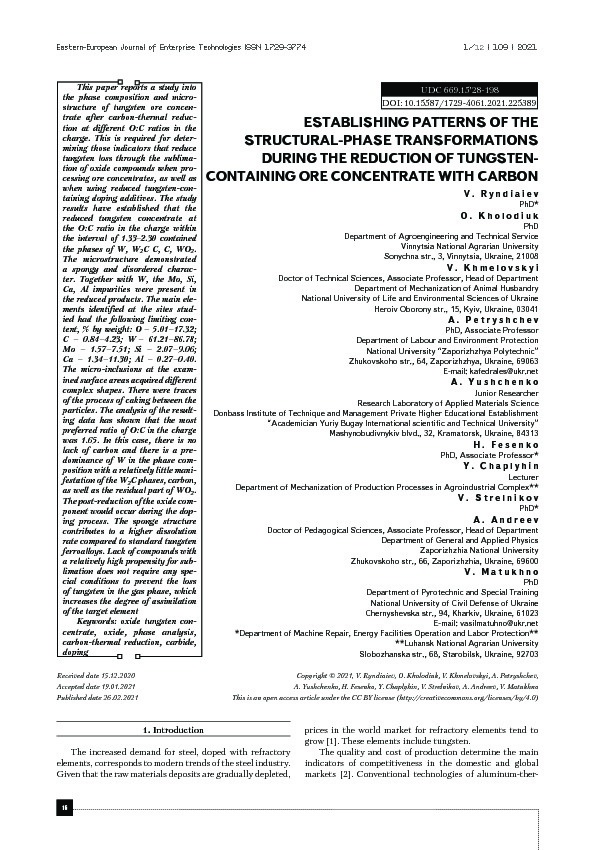id: 27956
Title: Establishing patterns of the structural-phase transformations during the reduction of tungsten- containing ore concentrate with carbon
Authors: Ryndiaiev V., Kholodiuk O., Khmelovskyi V., Petryshchev A., Yushchenko A., Fesenko G., Chaplyhin Y., Strelnikov V., Andreev A., Matukhno V.
Keywords: oxide tungsten con-centrate, oxide, phase analysis, carbon-thermal reduction, carbide, doping
Date of publication: 2021-03-01 08:05:12
Last changes: 2021-03-01 08:05:12
Year of publication: 2021
Summary: This paper reports a study into the phase composition and microstructure of tungsten ore concentrate after carbon-thermal reduc-tion at different O:C ratios in the charge. This is required for determining those indicators that reduce tungsten loss through the sublima-tion of oxide compounds when processing ore concentrates, as well as when using reduced tungsten-containing doping additives. The study results ave established that the reduced tungsten concentrate at the O:C ratio in the charge within the interval of 1.33‒2.30 contained the phases of W, W 2 C C, C, WO 2. The microstructure demonstrated a spongy and disordered character. Together with W, the Mo, Si, Ca, Al impurities were present in the reduced products. The main elements identified at the sites studied had the following limiting content, % by weight: O – 5.01–17.32;C – 0.84–4.23; W – 61.21–86.78; Mo – 1.57–7.51; Si – 2.07–9.06; Ca – 1.34–11.30; Al – 0.27–0.40. The micro-inclusions at the examined surface areas acquired different complex shapes. There were traces of the process of caking between the particles. The analysis of the resulting data has shown that the most preferred ratio of O:C in the charge was 1.65. In this case, there is no lack of carbon and there is a predominance of W in the phase composition with a relatively little manifestation of the W 2 C phases, carbon, as well as the residual part of WO 2 . The post-reduction of the oxide component would occur during the doping process. The sponge structure contributes to a higher dissolution rate compared to standard tungsten ferroalloys. Lack of compounds with a relatively high propensity for sublimation does not require any special conditions to prevent the loss of tungsten in the gas phase, which increases the degree of assimilation of the target element.
URI: http://repository.vsau.org/repository/getfile.php/27956.pdf
Publication type: Статті Scopus
Publication: Eastern-European Journal of Enterprise Technologies. 2021. № 1/12 (109), Р. 16–21.
In the collections :
Published by: Адміністратор
File : 27956.pdf Size : 1443230 byte Format : Adobe PDF Access : For all

| |
|
|